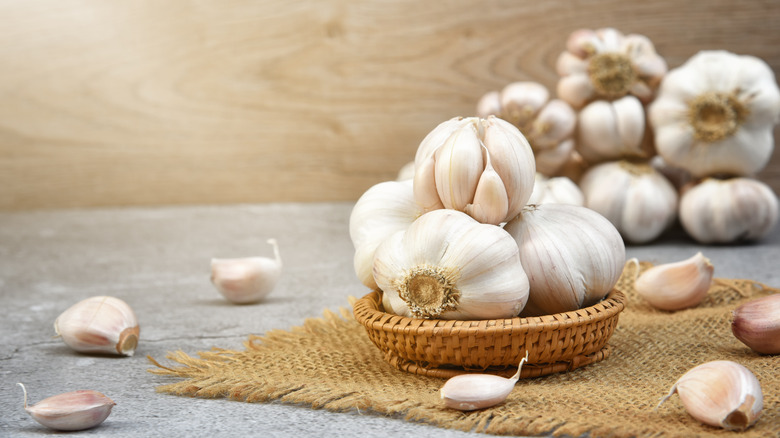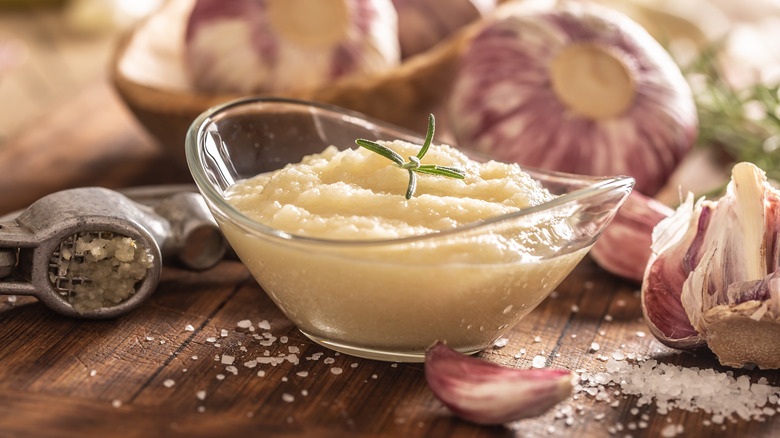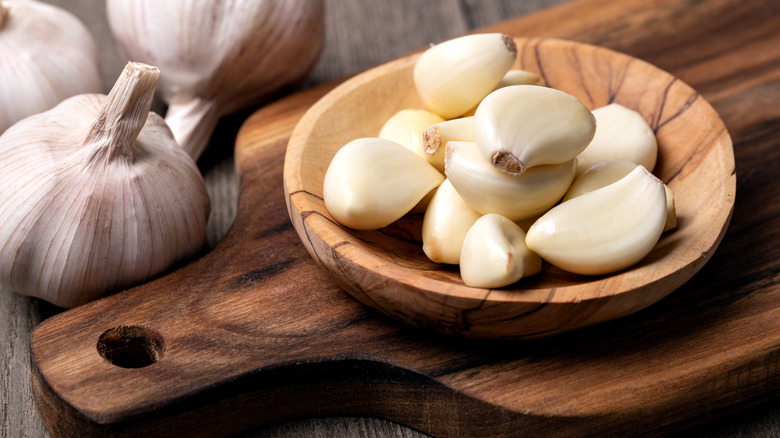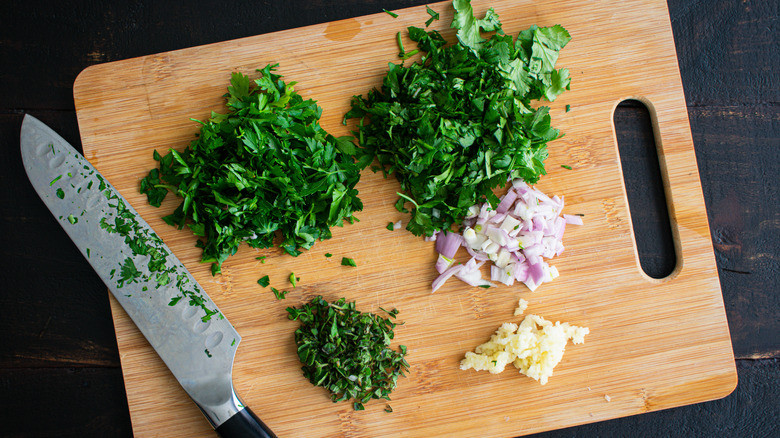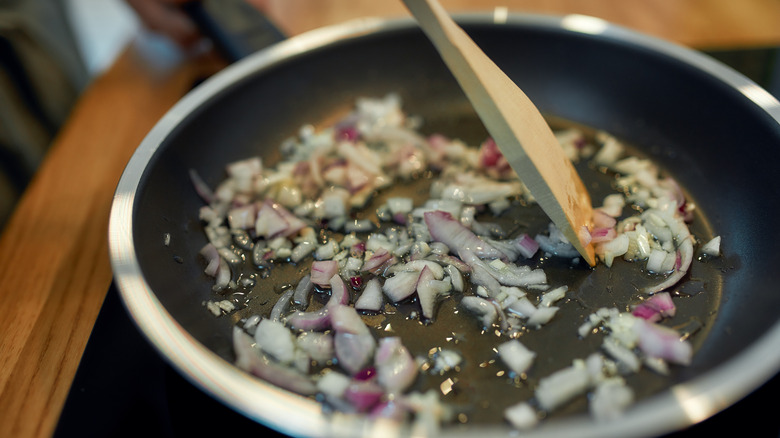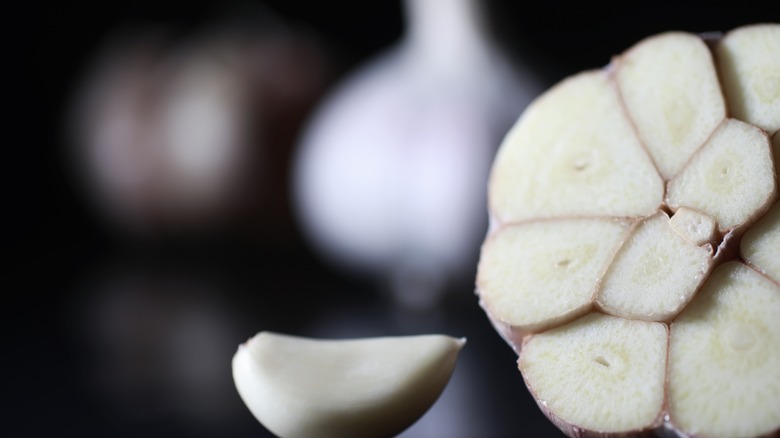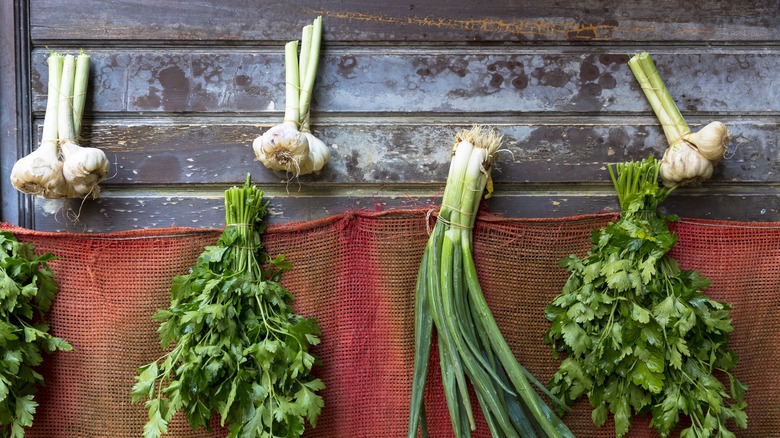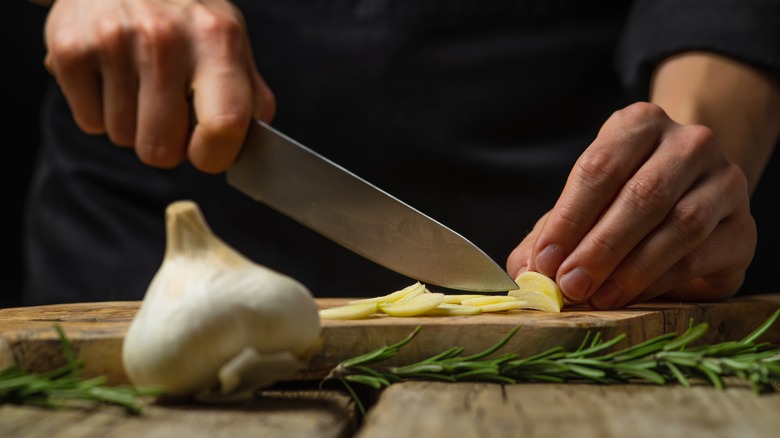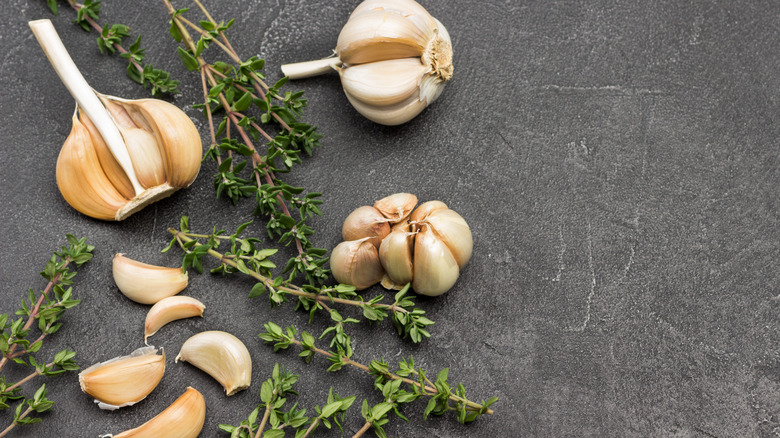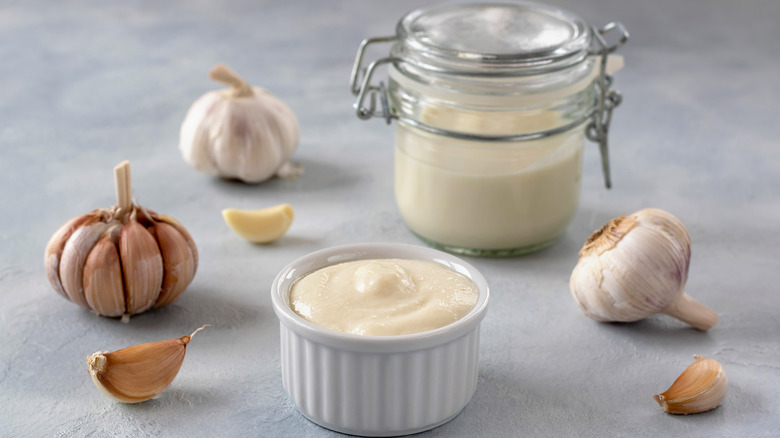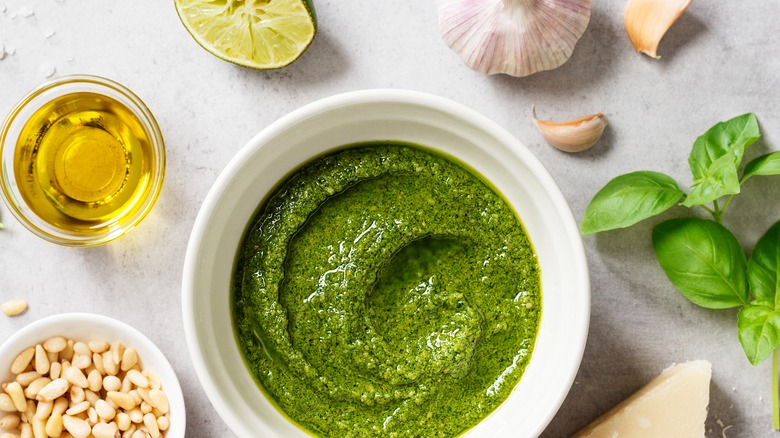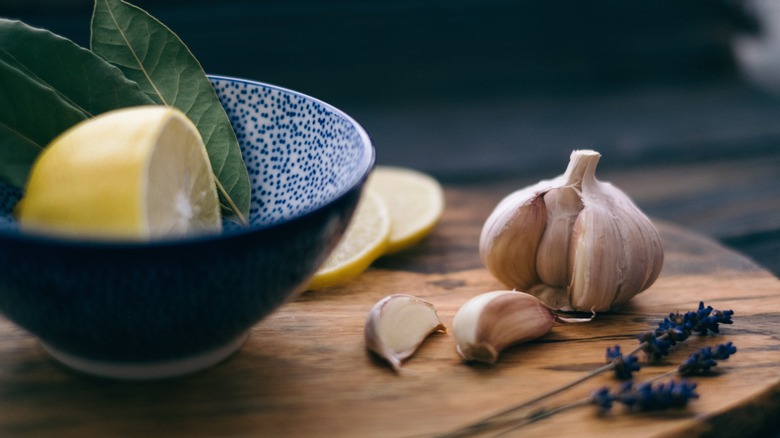Tips You Need When Cooking With Garlic
What do a heap of decadent mashed potatoes, herb butter spread on a freshly-toasted baguette, and a simmering pot of homemade spaghetti sauce all have in common? Our favorite aromatic, the monarch of the kitchen, the goddess garlic. Who doesn't love dropping a clove or two (or three) into their most beloved dishes, elevating them from meh to mouthwatering?
Garlic was one of the first discovered horticultural crops, used by Indian and Egyptian cultures as much as 5,000 years ago, and today, Americans purchase an estimated 121 million pounds of fresh garlic every year (via the USDA). It's a permanent fixture in multiple global cuisines, including Indian, Chinese, and Italian. As versatile and popular as this ingredient is, garlic can go wrong in many ways. It burns when you're just trying to brown it, can be a nightmare to peel, and either floods a dish with its flavor or doesn't shine through at all.
If this bulb has frustrated you in the kitchen, don't lose hope — there's still plenty of chances to rekindle a friendship with this cooking staple. It's time to make nice with garlic so that you can keep it ready in your kitchen arsenal.
Let garlic rest after cutting and before cooking
You've heard of the five-second rule for dropped food and the 30-minute rule for swimming after eating, but have you heard of the 10-minute garlic rule? After you've sliced or diced your cloves, leave them be for 10 minutes; in doing so, you are allowing the enzyme that creates the chemical responsible for garlic's anticoagulant, cancer-fighting, antibacterial properties to do its work before being exposed to heat (via the Chicago Tribune).
The enzyme is activated by cutting or crushing, but killed by heat, so by letting your garlic rest away from the fire, the enzyme has time to convert into allicin, a near-magic compound (via Nutrition Facts). While allicin will also start to be killed off by cooking, it is more resistant to heat, and more of it will make it to the other side if the conversion happens at room temperature.
Garlic's health benefits can also be maximized by eating the bulb raw. Raw garlic can be an intense taste to become acclimated to, but Well And Good recommends trying it out a few different ways. Consider tossing minced garlic in your salads, mixing minced raw garlic into butter or ghee, spreading it on toast, adding it to a juicer with other vegetables, or making an apple cider vinegar tonic with raw garlic.
Premake and store a confit for quick, versatile garlic
All garlic gurus swear by keeping a stock of garlic confit on hand. Garlic confit is slow-cooked in fat until it's tender and succulent. The resulting cloves can be used in any dishes from soups to pasta to roasted meats, or just spread over toast for some pure, garlicky goodness. Confit garlic cloves can make cooking with garlic more convenient and less time-consuming, as the cooked cloves crush easily and melt into dishes with no slicing or mincing necessary.
There are a multitude of ways in which you should be seasoning confit. For example, you can enrich it with other herbs and spices, like rosemary or basil. Garlic confit can be made with any neutral vegetable oil, but we recommend going for your favorite extra-virgin olive oil because not only will your confit yield you a jarful of flavorful, caramelized garlic, but you'll end up with a divine infused oil to cook with too.
To make garlic confit, simply peel and separate as many garlic heads that make sense for your cooking habits — usually, anywhere between two and five. Each garlic head will yield about one cup of confit. Put the whole cloves in your preferred casserole pan or deep baking dish, then pour a half-cup of oil for every head and top with whole leaves or sprigs of your favorite herbs. Roast your garlic for about two hours at 250 degrees F, or until the cloves are golden in color and soft.
Use whole cloves for a mild taste
Do you often feel like garlic dominates your food's flavor even though you're putting less and less in? If you're always using minced garlic or crushing your garlic into a fine paste, that's likely the culprit. Garlic's strong aroma and taste are owed to the chemical alliinase, which is released when the bulb is disturbed through slicing, mincing, or crushing. The more you break down garlic, the more this sulfuric compound is released, and the more your garlic flavor will intensify.
By not breaking into garlic cloves at all, the vegetable's plant cells will be completely undisturbed and thus won't release the allicin as sliced, minced, or crushed garlic would. Using whole cloves will invoke a milder, subtle garlic taste. This more modest flavor pairs well with dishes like our simple roasted chicken recipe, soups, garlic bread, and seafood — just to name a few. You can leave the cloves whole after your dish is cooked, or take them out, crush, and reincorporate — if you wouldn't prefer biting into an entire clove, that is. Doing so won't increase garlic potency since it's already been cooked.
Mince for a stronger flavor
Pining for a punchier garlic taste in your favorite dishes? Amplify the garlic by breaking it down into smaller pieces. If you're slicing, try rough chopping; if rough chopping isn't enough, try mincing. Mincing strongly affects the taste of garlic, and a teaspoon of this freshly-minced aromatic will create a more potent flavor than, for instance, a clove halved once and dropped into the pot. Each cut of the knife blade disturbs more and more plant cells in the garlic, releasing more alliinase, the enzyme responsible for the similarly pungent odor and taste of both garlic and onion.
The difficult question is then when you should use minced, sliced, or quartered garlic. The more you cook, the more you'll hone a personal preference for this, but here's a general guide to get you started: For stews, braising, or other slow-cook recipes, the cloves can be whole or slightly smashed; use thinly-sliced cloves in sautés and top your dish with the crispy pan-fried garlic chips; minced garlic fares well in salad dressing.
Always rehydrate freeze-dried garlic
Burning your ingredients in a pan or skillet can be aggravating and disheartening, especially if cooking for guests or trying a new recipe. If you often sauté your aromatics at the start of a recipe and your garlic stock of choice happens to be freeze-dried, be sure to always rehydrate the garlic morsels before putting them on direct heat. In the process of freeze drying, a product is first frozen and then put under a vacuum to draw out all of the water and liquid. The lack of moisture in the freeze-dried product will inevitably lead to blackened, bitter, burned garlic.
Some brands may come with reconstitution instructions, but generally, putting your desired amount of garlic in a small bowl and covering with hot water will quickly rehydrate the garlic. For recipes where the garlic is being incorporated in the dish but not being put on direct heat, rehydration isn't necessary, but using freeze-dried garlic as a sprinkle or garnish will yield very different textures than fresh garlic because of its lack of opportunity to absorb moisture.
Rehydrating will bring the potency of the garlic's flavor back to life. Let the reconstituting garlic stand for at least 10 minutes before using (via LA Times).
Freeze garlic wisely
Maybe you bought more garlic than you needed, or maybe you want to build up a back stock. Freezing garlic, when done correctly, can do a phenomenal job of preserving this aromatic until you need it. Flop the freezing process, however, and you'll be left with a bland pile of mush when it thaws. Garlic can be frozen raw in whole heads, as peeled cloves, chopped or minced, or in a paste. Or, it can be frozen after being roasted with olive oil, which makes dropping a bomb of flavor in your soups or leftovers a piece of cake.
According to MasterClass, whole heads of garlic will keep for around six months in the freezer, while peeled cloves or any form of broken-down garlic should be used within several weeks to prevent the risk of botulism. Raw garlic should also be frozen quickly after it's been cut — no more than a day or two later. As the garlic thaws, give it a hefty sniff and thorough look-over to check for any off sights or smells. If something seems up, it's best to toss it.
Another one of the best ways to keep garlic fresh is to roast it, then tightly seal it and store it for a couple of weeks. Thus, you can avoid prepping the ingredient when you need it for future use. Prepare the roasted garlic for quick use by freezing it in silicone ice cube trays with olive oil.
Buy fresh garlic when possible
For your garlic to work smarter and harder, don't buy it pre-minced at the grocery store. Buy fresh garlic, and your cooking will soon burst with vibrant flavor. However, jarred, minced garlic may taste stale and is likely to have lost much of its potency. If you don't believe us, Anthony Bourdain once explained one of the biggest mistakes everyone makes when cooking with garlic ... although in less delicate terms: "Misuse of garlic is a crime," Bourdain wrote in Kitchen Confidential.
Bourdain may have been a bit intense to describe pre-minced garlic as "vile spew ... rotting in oil," but plenty of amateur cooks agree that the premade stuff just can't hold a candle to dicing up a fresh clove. If the superior flavor still isn't enough to convince you, consider the possible health benefits. As a study reported in Science Daily details, fresh garlic just might be healthier for you, thanks to that aforementioned higher content of allicin, a chemical known for its anticoagulant and antibacterial properties.
An important acknowledgment is that while fresh garlic is preferred where possible, it is not required to be a good cook — especially if it is not affordable or accessible. Using fresh garlic versus premade minced garlic is a matter of privilege, not a matter of necessity. To buy in season, be mindful that farm-fresh garlic is typically available from June to August.
Cook with garlic liberally
Have you ever heard the phrase "measuring garlic with your heart?" There's a reason this slogan is used so much, particularly in the amateur cooking community. Garlic is a flavor that is difficult to overload. Some home chefs say they automatically double the garlic in a recipe and will make adjustments when they make it again if necessary; others say they'll never go less than triple (via Reddit).
"When garlic needs to be there, it needs to be there," says New York City executive chef David Watluck in The Flavor Bible. If you're not keen on chopping clove on clove of garlic every time you cook, we suggest you infuse your favorite olive oil for an easy gush of garlicky flavor.
Despite the playful saying, there is such a thing as too much garlic or garlic where it doesn't belong. Taste your sauces and dishes as you go along, and err on the lighter side if you're unsure of cooking something new. Some recipes will shine on their own without garlic, so don't feel obligated to add it every time.
Avoid burning garlic
You're making a multi-step recipe that calls for sautéed garlic. The only problem is that you're also stirring the sauce, cutting vegetables, and searing meat all at the same time. With only so many eyes and hands to keep track of everything, a burning smell catches your nose — it's the garlic, scorched in the pan again. It's frustrating and disrupts your recipe every time. Fortunately, we've got tips for keeping your aromatics from blackening to a crisp in the split second your back is turned.
One of the easiest ways to prevent your garlic from burning is by withholding it from the pan until the last minute. If you're cooking other vegetables or meats, get those near fully cooked before tossing in your garlic. This will preserve the garlic's flavor and its beneficial chemicals and keep it from burning up in the heat. The smaller the garlic's been prepared, the quicker it will burn — so minced garlic will sizzle up quicker than it would if it were sliced.
Avoid putting garlic on the fire if the heat is higher than medium, especially if cooking the garlic in oil; putting this allium in hot oil will scorch it almost instantly. For best results, keep your flame to medium heat or lower.
Understand different garlic types and their uses
You wouldn't use Red Delicious apples for a homemade apple pie, and you wouldn't put sliced yellow onion on a hamburger. Just as with many other things, there are many members and variations of the garlic family. Each one has its own best uses. Garlic itself is just one of 700 different species in the allium genus, along with onions, leeks, and scallions (via Gardening Know How). There are two types of garlic — softneck, and hardneck — and within each type are multiple varieties.
Most of the garlic that's ever passed through your kitchen has more than likely been artichoke garlic, a softneck variety that tastes familiar and versatile. Artichoke garlic fares well in anything from mashed potatoes to seafood. Rocambole is a common hardnecked garlic, often recognizable for its more purplish hue and fewer but bigger cloves. While rocambole doesn't keep as long in storage, its flavor is more robust and complex, generally regarded as sweeter than others, and is often enjoyed raw.
Solo garlic also called pearl garlic or lazy garlic, is actually just a single, large, round clove rather than a head with many. Its flavor is less pungent than standard garlic, but its shape makes slicing much easier. Put garlic through the Maillard reaction, where it's broken down through a combination of heat, time, and acids, and you'll end up with black garlic, a dark-colored variation that is tangy and smoky — delectable in pasta and spreads.
Combine with complimentary flavors
Garlic will sit with just about anybody, but she's got some preferred company. To truly see garlic in all of its best forms, be sure to use it with the herbs and ingredients that complement it the most. According to The Flavor Bible, a chef-built thorough guide to just about every flavor in the culinary world, the top tier of garlic besties is lemon, olive oil, tomatoes, and vinegar, especially balsamic and red wine.
Following these most supportive ingredients is a secondary tier that will still bring garlicky dishes to a whole new level: basil, Parmesan, chicken, lamb, mushrooms, mustard, onions, and thyme. However, this is meant to be just a framework and not iron-clad rules. Manhattan chef and James Beard award nominee Alexandra Raij sautés her garlic with "parsley, red pepper flakes, and an acid like lemon juice or vinegar to make a vinaigrette. You can even add some stock, like a fumet," she says in The Flavor Bible.
For inspiration on combining garlic with your other favorite ingredients, look to cuisines like Mediterranean, Mexican, Creole, and Thai.
Soak garlic for easy peeling
There's nothing to suck the fun out of cooking quite like standing at the counter to painstakingly peel 10 garlic cloves. Tons of hacks for peeling garlic are floating around out there — a popular one includes putting the cloves in a jar and vigorously shaking it until the skin separates from the clove. But if you're not looking for an upper body workout or need something more accessible, there are other ways.
Making garlic cloves easily peelable is as simple as dropping them in a bowl of warm water for up to 20 minutes before you need to peel them. After at least 15 minutes, take the cloves out of the water and rub them in your palms to remove the softened skin, which swells in the water to become easily removable — a no-shake, no-mess solution.
If you need large quantities of the aromatic peeled, Netflix culinary star Nadiya Hussain recommends dropping whole bulbs of garlic in boiling water for around one minute in her show, "Nadiya's Time To Eat." After cooling to a touchable temperature, the cloves will peel very easily, she says.
